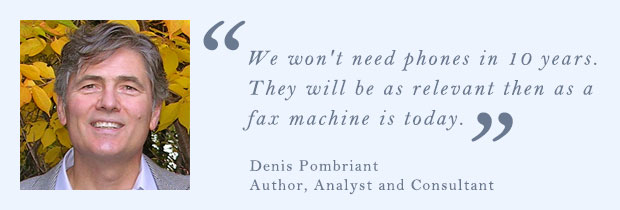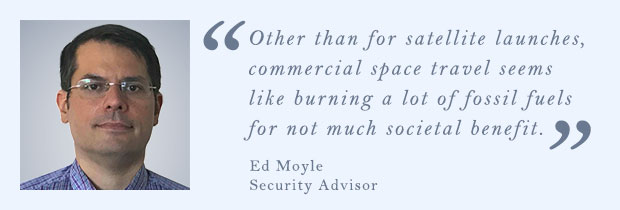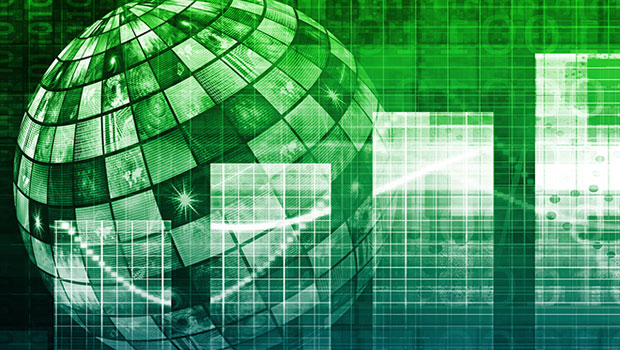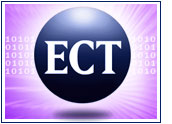Perhaps technology operates at its most profound level when we don’t notice it — when it simply becomes woven into the fabric of our daily lives. We’re not amazed when we flip a light switch, after all, and in a few years it might be second nature for many of us to say “Alexa, turn on the lights.”
As part of a far-ranging, weeks-long virtual discussion, we asked ECT News Network’s roundtable of industry insiders to pause and reflect on their own personal tech preferences, to speculate on what popular gadgets may vanish from use in the next decade, to consider the role of wearable health tools — and then to expand the discussion to the health of the planet, tech advances in traveling on it, and the prospect of leaving it altogether.
Roundtable participants contributing to the conversation were Laura DiDio, principal at ITIC; Rob Enderle, principal analyst at the Enderle Group; Ed Moyle, partner at SecurityCurve; Denis Pombriant, managing principal at the Beagle Research Group; and Jonathan Terrasi, a tech journalist who focuses on computer security, encryption, open source, politics and current affairs.
The Tech We Love
An interesting selection of hardware and software made the cut as favorite tech tools for our roundtable participants, including smartphones, tablets and laptops; home security tools; desktop operating systems, and some tried-and-true software applications.
Laura DiDio put her mobile phone, her iPad, and her Ring security camera at the top of her list.
Rob Enderle found his Fire HD 10 Tablet most indispensable, but after further thought named his Arlo security system, his Motorola One Action Phone and his HP Spectre Folio leather laptop as favorites too.
“I just thought of another tool, Grammarly, which likely reduces the load I put on my editor,” he added.
“Does Linux count?” asked Ed Moyle.
“If so, Linux. If not, KDE Plasma,” he said with a virtual wink.
“I’m glad I’m not the only one who loves their Linux desktop, Ed,” said Jonathan Terrasi. “I have had to use Windows considerably more for work as of late, and it makes me appreciate my Linux system so much more. Now if only I could put in more time on the command line… .”
Denis Pombriant chose his computer operating system first too, but for him it’s macOS.
“I still use my Mac more than phone or iPad, which I also own and use,” he said.
“Mobile devices are good consumption engines but I am a creator, and it will be a long time still before those devices are suitable for creators,” Pombriant added. “We don’t pay enough attention to the different needs of creators and consumers and often assume end users are all consumers but nothing could be further from the truth.”

Terrasi homed in on his software preferences.
“I’m actually a bit old-fashioned. I tend to prefer things like RSS over modern news aggregators for their simplicity and customizability,” he said.
“If I had to pick my favorite tool for personal productivity, though, it’s probably IFTTT — short for “If This Then That.” Think of it like a graphical scripting interface for linking together the different services in your life conditionally,” Terrasi continued.
“For instance, you can set it to text you in the morning if the forecast for your area will have rain that day. It’s an incredibly versatile tool that brings API interconnection to the masses,” he said.
A World Without
As much as they might enjoy using certain tech standbys today, our panelists were unsentimental about consigning many of their favorite things to the dustbin of the future.
Although he’s a Fire tablet fan now, in 10 years tablet computers are likely to be obsolete, predicted Enderle, with the exception of smartphones with foldable screens.
“Smartphones should do to tablets what they did to standalone music players like the iPod,” he said.
“Tablets will probably collapse as a market in 20 years,” agreed Terrasi.
“Despite the fact that I have one and like it, I concede that there’s no really good reason for them to exist since, in my experience, people tend to favor either 6-inch screens or 15-inch ones — and larger.

Pombriant’s crystal ball told a different story when asked which popular tech is likely to fall by the wayside.
“Believe it or not, the mobile phone. We are shrinking it to the wrist and to goggles. We won’t need phones in 10 years. They will be as relevant then as a fax machine is today,” he said.
“Not sure if the tablet will follow, because that form factor has additional uses for data capture — but you never know,” Pombriant added.
“I don’t doubt that we’re eventually moving to goggles and/or watches — there’s nothing particularly special or intrinsically pragmatic about the phone form factor — but I don’t know if they’ll be dominant in only 10 years. Google Glass didn’t exactly precipitate a revolution,” observed Terrasi.
Wearable technology, including the beginning of surgically embedded technology, will make our personal tech today seem very antiquated in 10 years, suggested Enderle.
Moyle fingered an entirely different tech category as on the way to obsolescence: integrated automotive navigation systems.
“There’s really no reason to have this. As soon as someone figures out how to project an interface from a mobile device onto a car HUD or integrated screen, there’s no reason to have a separate system built into the car,” he reasoned.
“Autonomous cars will undoubtedly make pretty much all existing in cabin car technology obsolete,” said Enderle.
On the other hand, “people really don’t like change much,” he noted, so even though they might be pass, a lot of tech tools likely will still be around in some form.
“Could someone please take FAX machines our of our misery?” he implored. “They should have been dead a decade ago, and have become a showcase for how long a dead technology can continue.”
Healthy Attachments
Wearable health monitors include everything from Fitbits and Apple Watches to more specialized medical devices. They can collect an enormous amount of data on users’ personal health statistics and exercise patterns.
In addition to supporting users’ health and fitness goals, they can aid clinicians in diagnosing conditions and guiding treatment.
Although adoption appears to be on an upward trend, our panelists expressed reservations.
They can be beneficial “when used as more than a toy,” said Moyle, by people “with conditions that require ongoing monitoring.”
However, “for the general population, I’m a little concerned about privacy,” he added.
At some point, they could become vulnerable to hack attacks, suggested Terrasi.
“Currently, there aren’t enough devices like these in circulation for them to pose lucrative attack targets, but once they proliferate to be more common among consumers, I think we will see new attack models that take advantage of their relatively unproven security,” he said.
“Every time a new class of devices come into being, it goes through an initial phase of relative insecurity before development practices tighten up, for the simple reason that these developers haven’t put in the time and experience — and repeated failure — that, say, the Unix and Windows developers have put in to know what not to do,” Terrasi explained.
“Beyond the comparatively lower level of experience that health device developers have, there are complications to securing these devices that are inherent to their function and design,” he pointed out.
“Because their form factor is small and their function is narrow, they tend to have less computing power and favor protocols like Bluetooth Low Energy. Security researchers have shown that this protocol has serious security issues — the kind that should make consumers think twice about passing personal health information back and forth over it,” said Terrasi.
“At the very least, it opens up a new vector for tracking you in physical space. If an attacker figures out what your device’s address number is, they can figure out where you are by seeing where it pops up,” he continued.
“These are all concerns that device manufacturers and developers will need to seriously address before these devices are ready to handle the intimately personal data they are party to,” Terrasi warned.
“I agree this is a significant threat,” said Enderle, but “I also think it isn’t a critical problem for the next couple years.”
Tech to the Rescue
One problem that extends far beyond personal health concerns is the health of the planet we all occupy. Rather than attempting to untangle the complexities of the climate change problem in general, we asked our panelists to focus their discussion on what the tech industry can do about it entirely on its own, with or without official government actions.
“Lots,” said Pombriant.
“Various companies, like Salesforce, are doing things — but their actions are primarily retrospective,” he said.
“Here are some things we can do without government, Pombriant continued. “In fact technological disruptions always start away from government and this is one example:
- Put some R&D money into carbon absorption approaches and publicize. There are technologies available.
- Install electric vehicle charging stations at their building and install more than needed.
- Bring the company’s infrastructure up to LEED standards.
- Commit to becoming carbon neutral by a date certain.
- Buy only renewable electricity.
- Use philanthropic approaches like Salesforce’s Philanthropy Cloud to support individual climate actions like planting trees, cleaning up rivers etc.
- Adopt inner city areas for green use such as sponsoring community gardens.
- Consider electric busses and trucks for local uses.
- Agitate for open carbon markets and trading.”

DiDio also saw a large field of possibilities.
“The tech industry and its leaders make billions. They should be leaders and devote a portion of their R&D monies — create a special fund — and annual revenues,” she suggested.
They should “build products that are green and support green initiatives. Individually and collectively, the technology industry should be vocal in their support for sustainability initiatives, renewable energy sources, handling of disposable and hazardous waste materials — not dumping on third world countries,” DiDio said.
“And they should practice what they preach — setting a good example at their own assembly and manufacturing facilities and corporate offices,” she added.
“Since the government has clearly stepped back from these efforts, the major tech companies have gone farther to step up,” observed Enderle. “Certainly their sustainability efforts focus on this both in terms of product design and their use of disposable materials and renewable energy.”
“To my growing list, I’d add making recycling easier to accomplish,” said Pombriaant.
“Apple does this, and other tech providers do too — but we need a culture change to support recycling,” he said.
“Also, products need to be made to be repairable by the home hobbyist. You can’t even open some of these things today without special tools. We can at least make the tools easier to get,” Pombriant suggested.
“Sadly, the most practical thing the tech industry can do is also the thing they’re least likely to do, which is for each manufacturer to stop churning out millions of units each of multiple models of new devices every year,” said Terrasi.
“The materials that are required to manufacture digital devices — from smartphones to laptops to everything in between — involve a complicated extraction process that results in huge volumes of noxious pollutants being dumped into the atmosphere,” he pointed out.
“Instead of resolving, as an industry, to slow their production schedules — maybe releasing new models every two or three years as video game console manufacturers do — instead, they not only release new devices yearly, but they stop supporting security updates to their devices after as little as three years,” Terrasi noted.
“As a consumer, you are then forced to either buy a new phone every three to four years in spite of the fact that usually the hardware is still functional, or face the near certainty that your device will get compromised after new vulnerabilities are discovered and left unaddressed for your current ‘end-of-life’ device,” he said.
“Terrasi’s position is on point,” said Enderle.
“We need to fundamentally move from a forklift upgrade product methodology to one that favors upgrades in place and 100 percent recycling. The planet can’t take much more of this, and we don’t have an easy one to move to another one,” he added.
“This is an issue that requires concrete thinking and explicit professional solutions,” said Pombriant.
“There are too many opinions floating around that may be well intended but that don’t solve the problem and/or don’t scale and thus don’t provide solutions either,” he continued.
“We need to get serious about the issues, and that means educating the public so that it has a basic working knowledge of things like the second law of thermodynamics, which can be boiled down to, ‘there’s no free lunch,'” Pombriant said.
Moyle identified “more and better green computing options” as one path the tech industry can take on its own.
For example, large cloud services providers could undertake power conservation initiatives at their datacenters, he said.
“Fundamentally, though, the problem is that in one form or another, energy consumption keeps increasing exponentially as technology evolves and consumer demand for new technology grows,” said Terrasi.
“No company wants to miss out on making these advances or tapping into this demand, so asking data centers to conserve energy is asking them to unilaterally disarm, and that’s not realistically going to happen absent regulation,” he maintained.
“The more reliable solution would be to outflank regulation and make the power grid itself greener, so that at least electricity-guzzling data centers aren’t doing as much damage,” Terrasi suggested.

“I like the idea of a major focus on the power grid,” said Enderle.
“Our ad hoc approach is creating problems, and given projections suggest a sustained grid failure would wipe more than two-thirds of us out, this last should be a greater concern than it is,” he added.
“Even moving to vegetable-based meats in their own cafeterias would set an example and help mitigate a lot of the problem. I think it would be really sad if the race died out due to cow burps,” Enderle quipped. “Overall, I think the industry should move from competing with each other on this and toward a broad cooperative effort. If we all die out it really won’t matter much if one company was greener.”
On the Road
Tech advances on the horizon in the transportation sector could work in tandem with larger efforts to combat climate change.
We can expect more electric cars like the Mustang E, Enderle said.
“We finally have a number of electric pickup trucks as well — which make more sense, due to their normal duty cycles, than most of the electric vehicles currently in market,” he added.
“Mercedes Benz has an SUV in showrooms in 2020 that’s fully electric,” noted Pombriant.
“It costs (US)$67,500. Audi, Volkswagen, Nissan, Honda, Toyota, GM and Ford all have products in or coming to market,” he said.
“Buy one. Understand that the success of the EV is dependent on diffusion of charging technology,” Pombriant urged.
We’ll soon see “higher-speed car chargers — and more of them — thanks to VW’s settlement,” noted Enderle. “As a side note, I just picked up a 50 Amp ChargePoint charger for my electric, suggesting we are moving from the old 35 amp standard. Expect to see more of those as well.”
Other emerging transportation tech includes level 3 autonomous driving, face recognition used more widely for clearing security and boarding flights, and expansion of drone delivery services, Enderle said.
Off the Planet
Our panelists were less sanguine about technology developments in support of transporting us off-planet.
Technologically viable and commercially affordable commercial space travel is still a long way off, said DiDio.
“This is a dumb idea. It doesn’t add to the welfare of the planet, and there’s too much needed here at home,” said Pombriant.
“That said, a solar farm at a geostationary orbit could capture huge amounts of energy and transmit it to Earth via microwaves,” he suggested.
“You’d need a space elevator — the theoretical work is done — to avoid the expense of rockets for commuting purposes,” Pombriant added.

“Other than for commercial satellite launches, it seems like a lot of fossil fuels to burn for not much societal benefit,” observed Moyle.
“Until they better deal with both the price and motion sickness issues this service is going to be very hard to get off the ground,” added Enderle (prompting “I see what you did there!” from Moyle).
“Having done the zero G flight, you certainly won’t get me paying that kind of money for a quick trip into space. However if we don’t stop global warming we may have to live there,” he said.
“I’ve always loved the idea of a space elevator — the damn cable weight remains the biggest impediment, though,” Enderle continued.
“But what are you going to do in a space hotel? It will be size-constrained, a meteor could spoil your entire year, and being sick for days is bad enough on a ship,” he remarked.
“Just put a satellite into space with real-time high resolution 8K HDR cameras and then use the images to simulate the experience,” Enderle proposed. “I’ll bet Disney could do this better, faster and cheaper than actually having to go to space.”





















































